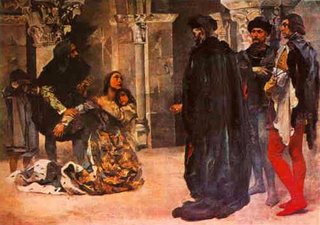Imagery IV – FIGURES II.1 - Ines de Castro - The Tale

Inês de Castro was a Galician noblewoman, daughter of Pedro Fernandez de Castro, lover and posthumously declared lawful wife of the Portuguese King Pedro I and therefore Queen of Portugal. Inês came to Portugal in 1340 as a maid of princess Constance of Castile, recently married to Prince Pedro, the heir to the throne.
The prince fell in love with her and started to neglect his lawful wife, endangering the already feeble relations with Castile.
Moreover, Peter's love for Inês brought the exiled Castilian nobility very close to power, with Inês's brothers becoming the prince's friends and trusted advisors. King Afonso IV of Portugal, Peter's father, disliked Inês's influence on his son and waited patiently for their mutual infatuation to wear off.
Unfortunately for the King's relationship with his son, it did not. Inês and Peter kept seeing each other despite royal disapproval.
In 1349, Constance of Castile died. Afonso IV tried several times to remarry his son, but Peter refused to take a wife other than Inês, who was not deemed eligible to be queen.
Meanwhile, Peter's legitimate son (future king Fernando I of Portugal) was a frail child, whereas Peter and Inês's illegitimate children were thriving. This created even more discomfort among the Portuguese nobles, who were frightened of the increasing Castilian influence over Peter. Afonso IV banished Inês from the court after Constance's death, but Peter remained with her.
After several attempts to keep the lovers apart, Afonso IV ordered Inês's death. Peêro Coelho, Álvaro ConçAlves and Diogo Lopes Pacheco went to the Monastery of Santa Clara in Coimbra, where Inês was detained, and killed her. Inês's death did not bring Peter closer to his father; following his lover's death, he rebelled against Afonso IV and dragged the country to a civil war.
Peter became King of Portugal in 1357. He then revealed to the country that he had secretly married Inês and that she was the lawful queen of Portugal. The king's word was, and still is, the only proof of the marriage, but Peter took Inês's body from the grave and forced the entire court to swear allegiance to her as queen.
She was later buried at the Monastery of Alcobaça where her marble coffin can still be seen today just opposite of her king's. Both coffins were carved out of marble and exquisitely sculpted with scenes from their lives and a promise by Peter that they would be together "ate a fim do mundo", in English "till the end of the world".
Inês de Castro’s life is immortalized in several plays and poems in Portuguese and Spanish language, including The Lusíadas by Luís de Camões and "Reinar despues de morir" by Luis Velez de Guevara.


<< Home